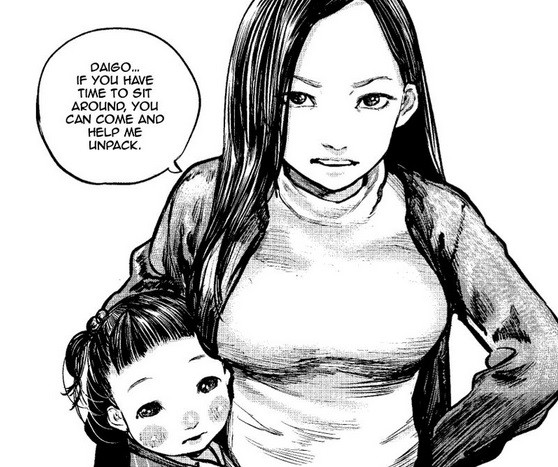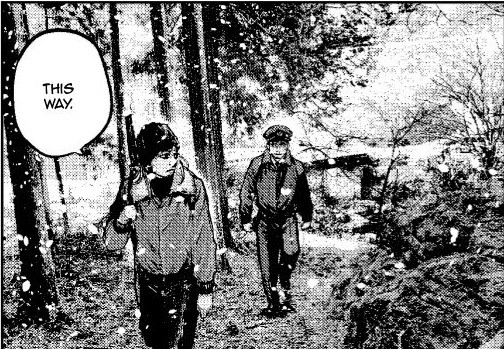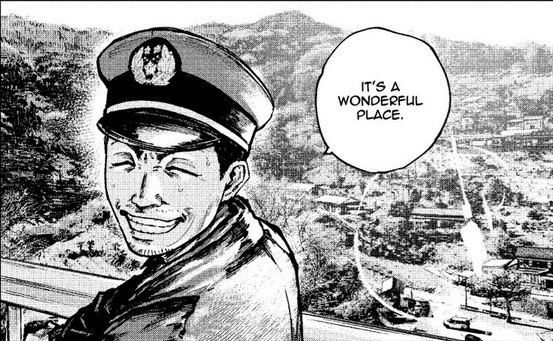
INTERVIEW: Small-Town Horror Comes to Life in Masaaki Ninomiya’s GANNIBAL Manga
© Masaaki Ninomiya 2019 TM & © 2024 ABLAZE LLC. All Rights Reserved
Is Masaaki Ninomiya‘s horror manga Gannibal folk horror? It certainly fits a lot of the subgenre’s definition. Set in a strange, isolated mountain village, it touches on how ritual can influence insular communities and how that looks to outsiders – and even more importantly, how outsiders look to the residents. With themes of ritual cannibalism and distrust of outside authority figures, the story bears comparison to works like Higurashi: When They Cry, but only on the surface; there are no time loops or bishoujo trappings here. But Ninomiya doesn’t necessarily think of it that way.
“I just learned the word “folk horror” for the first time, and I really don’t know much about it…Stories from folklore and history aren’t scary because they are multi-faceted but because they have depth. People are also afraid of the unknown, whether it’s cannibalism or rituals.” That’s certainly a fair point, and that fear of the unknown makes horror such an effective genre, particularly when paired with its sister genre, terror.
The story of Gannibal follows a family of outsiders when the husband takes a job in Kuge Village. Ninomiya said that he was very cognizant of the isolated nature of the town, noting that it’s “a closed space cut off from the outside world.” This idea of being remote and essentially alone and isolated from the rest of the world is a theme played out in various ways across Gannibal‘s first volume.
One of the characters, the young daughter of the Agawa family, is nonverbal due to a trauma in her past, which had the effect of keeping her even further isolated from the village and even her parents. When asked about the decision to have her trauma manifest in this way, Ninomiya remarked, “When I thought of the last scene for the first chapter, if it were a normal child, they would have been able to tell their parents about the situation. And I think the sense of urgency would have been different.”

© Masaaki Ninomiya 2019 TM & © 2024 ABLAZE LLC. All Rights Reserved
Having a character who cannot tell people in positions of power what she has witnessed enhances the horror elements. The fact that she’s a small child feels like an acknowledgment of children’s longstanding role in horror fiction while noting the various ways trauma can affect different people. That’s something worth keeping an eye on as the story unfolds, especially as we learn more about what happened to Agawa’s predecessor and see people’s reactions to each new and terrible event.
Ninomiya’s works may fall under folk horror and terror, but he didn’t set out to work in those genres specifically.
“I didn’t really think of it as horror when I drew it. I think because I aim for shocking content, my works turn out horror-like. But I didn’t set out to become a horror writer; it just happened out of necessity. I would also like to try drawing something more horror-oriented in the future. Because of that, I haven’t intentionally exposed myself to horror manga or novels. However, the movie that gave me the first hint for [Gannibal] was The Shining. So, I think [the manga] was influenced by that [movie].”
Ninomiya admitted he has a lot of influences on his work, from horror films to popular shonen manga. He cited the Taiwanese horror film Incantation as an “interesting new movie” that caught his attention. His manga influences spanned multiple genres, from Kazuhiro Fujita‘s Ushio & Tora and Karakuri Circus to the work of Hideki Arai (The World is Mine, Miyamoto kara Kimi e).
“Of course, I’m not only influenced by those two but also by all kinds of manga and movies,” Ninomiya said. “For example, the last scene of Gannibal‘s second chapter was inspired by the last scene of [the movie] The Hunt. I think every scene [from Gannibal] is influenced by something, even if I wasn’t thinking about it like the above scene.” This mix of influences is easily seen in the manga, which blends familiar elements of shonen and seinen works in its pacing and artwork.
That artwork is among the standout features of Ninomiya’s work. The density of the forest, reminiscent of Shigeru Mizuki‘s work, makes it a character in and of itself. Ninomiya noted, “Like the forest, you don’t know what will emerge from beyond the darkness… You could say the unknown is the fundamental fear, not curiosity,” something which really contributes to the overall atmosphere of the manga.

© Masaaki Ninomiya 2019 TM & © 2024 ABLAZE LLC. All Rights Reserved
Even more impressive is that they come mostly from Ninomiya’s imagination: “The backgrounds are mostly drawn by combining various photos I have taken or using the same photos as they are. There aren’t many reference materials in my workroom, so I draw them on my own.”
While it might not seem like a feat to draw dense forests from a few photos and your own mind, a look at the backgrounds for the area around Kuge Village reveals the enormous amount of work that had to go into them. “It’s 100% drawn on a computer, without using any paper,” Ninomiya said. “Even though I’m using a computer, it’s just an auxiliary tool. So, when I’m not sleeping, I’m drawing almost all the time. It’s tiring.” This attention to artistic detail doesn’t necessarily allow for everything the creator would like to spend time on, unfortunately. Ninomiya couldn’t make more elaborate costumes or do as much research into funeral rituals and other similar folkloric elements. However, it must be said that this isn’t readily apparent in the manga.
ABLAZE’s release of the Gannibal manga isn’t the first time the story has made its way to foreign audiences. A live-action adaptation was produced in 2022 and is available on Hulu with English subtitles. Ninomiya is generally pleased with the adaptation and noted, “I was worried [at first] because I didn’t know how good the drama would be until I saw it. But it’s high quality, and I got the impression they were trying to make something really good. So, I wasn’t worried about the reaction from overseas viewers.”
He went on to say, “I’m much more worried about how the manga will be received in English-speaking countries.” That’s always a valid fear, but Gannibal has a lot of what it takes to be successful – it’s a blend of folk and gruesome horror, replete with characters who think they’re doing not just the right thing, but the only thing to do. The story’s isolated setting contributes to the sense that it’s the place that warps the people rather than the other way around.

© Masaaki Ninomiya 2019 TM & © 2024 ABLAZE LLC. All Rights Reserved
“Although this is a story about Japan, an island nation in the East, I wrote [Gannibal] so that it feels like it could realistically happen anywhere in the world,” Ninomiya said. He has largely succeeded in that, even as he tells us, “You don’t have to listen to this author’s opinion. If you pick [Gannibal] up and have fun reading it, nothing will make me happier.”
If you like horror manga, this really is worth giving a chance. Ninomiya said he’s looking forward to the reactions of English-language readers, adding, “I’ll be egosurfing, so please let me know what you think on social networks. I look forward to it!!”
ABLAZE will release the first volume of GANNIBAL in English on June 11.
